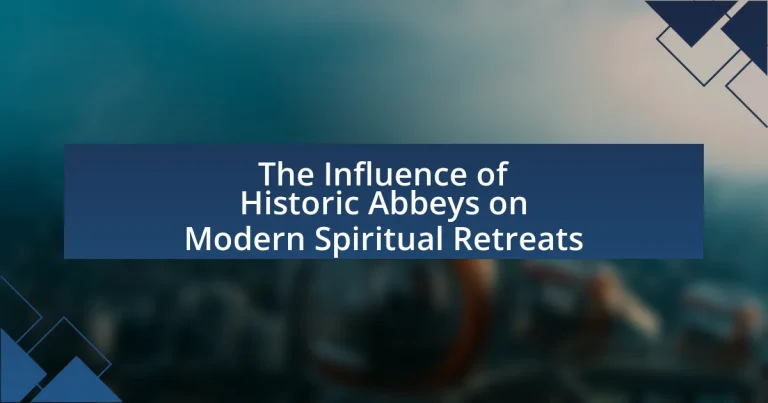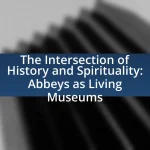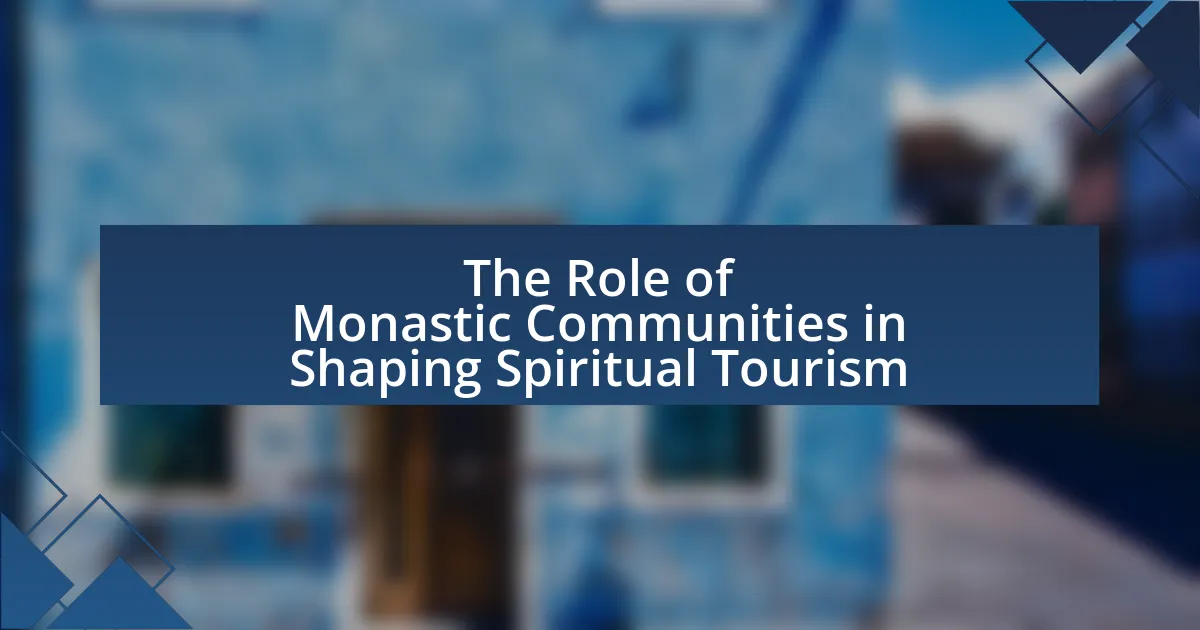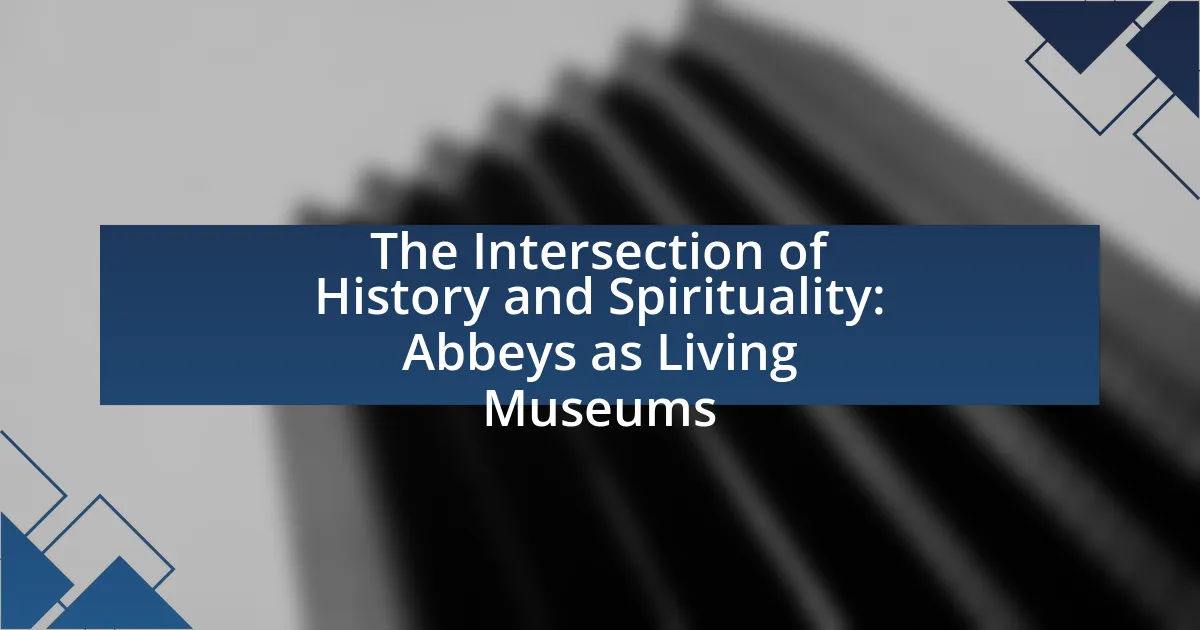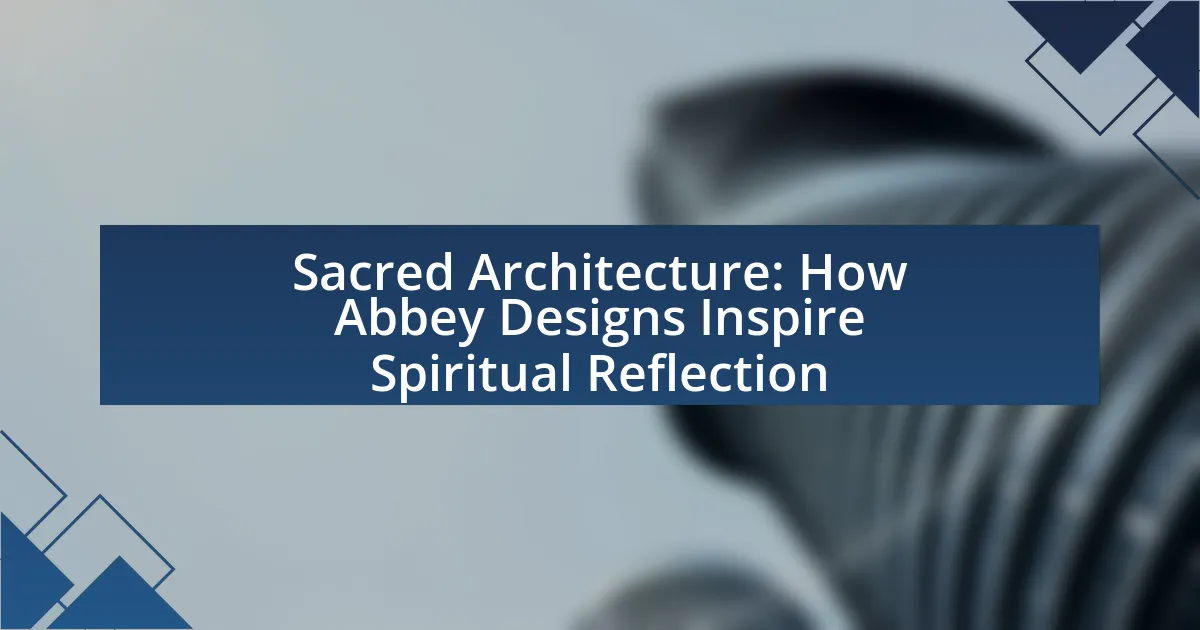Historic abbeys, as centers of monastic life, have significantly influenced modern spiritual retreats through their structured practices, architectural designs, and communal living. This article explores the historical significance of abbeys, detailing how their routines of prayer and meditation shaped spiritual practices and community dynamics. It examines the architectural features that enhance spiritual experiences, the evolution of abbeys into retreat centers, and the incorporation of traditional practices into contemporary retreat models. Additionally, the article addresses the challenges and opportunities in blending historic traditions with modern spiritual needs, highlighting the psychological benefits participants gain from these retreats.

What are Historic Abbeys and Their Significance?
Historic abbeys are religious buildings that served as centers for monastic life, often associated with specific orders such as the Benedictines or Cistercians. Their significance lies in their roles as places of worship, community, and learning, contributing to the preservation of religious texts and cultural heritage throughout history. For example, the Abbey of Cluny, founded in 910, became a model for monastic reform and influenced the development of Western monasticism. Additionally, many historic abbeys are now sites for spiritual retreats, reflecting their enduring legacy in promoting contemplation and spiritual growth in modern contexts.
How did historic abbeys influence spiritual practices?
Historic abbeys significantly influenced spiritual practices by serving as centers for monastic life, prayer, and community worship. These abbeys established structured routines of daily prayers, known as the Liturgy of the Hours, which shaped the spiritual discipline of countless individuals. The Rule of St. Benedict, for example, emphasized balance between prayer, work, and study, creating a holistic approach to spirituality that many modern spiritual retreats still follow. Additionally, the architectural design of abbeys, often featuring tranquil gardens and serene environments, fostered contemplation and meditation, further embedding these practices into the spiritual lives of individuals. The legacy of these practices continues to resonate in contemporary spiritual retreats, which often draw inspiration from the monastic traditions established in historic abbeys.
What architectural features of abbeys contribute to spiritual experiences?
The architectural features of abbeys that contribute to spiritual experiences include high vaulted ceilings, large stained glass windows, and tranquil cloisters. High vaulted ceilings create a sense of awe and elevate the spirit, often designed to draw the eye upward, symbolizing a connection to the divine. Large stained glass windows filter natural light into vibrant colors, enhancing the atmosphere and evoking emotional responses that can deepen spiritual reflection. Tranquil cloisters provide serene outdoor spaces for contemplation and prayer, fostering a peaceful environment conducive to spiritual growth. These elements are historically rooted in the design of abbeys, which aimed to inspire reverence and facilitate a connection with the sacred.
How did the monastic lifestyle shape community and spirituality?
The monastic lifestyle significantly shaped community and spirituality by fostering a structured environment for communal living and shared religious practices. Monasteries served as centers of spiritual growth, where individuals committed to a life of prayer, work, and study, creating a strong sense of belonging among members. This communal aspect encouraged collaboration and mutual support, which reinforced spiritual development and collective worship. Historical evidence shows that monastic communities, such as those established by St. Benedict in the 6th century, emphasized the importance of communal prayer and the Divine Office, which structured daily life around spiritual activities, thereby deepening the spiritual experience of individuals and the community as a whole.
What role did historic abbeys play in the development of spiritual retreats?
Historic abbeys served as foundational sites for the development of spiritual retreats by providing dedicated spaces for contemplation, prayer, and community living. These religious institutions, often situated in serene environments, facilitated a structured approach to spiritual growth through their monastic practices, which emphasized solitude, meditation, and communal worship. For instance, the Rule of St. Benedict, established in the 6th century, outlined a lifestyle that encouraged balance between work, prayer, and study, influencing the retreat model that many modern spiritual centers adopt today. The architectural design of abbeys, featuring cloisters and quiet gardens, further supported the retreat experience by creating tranquil settings conducive to reflection and spiritual renewal.
How did the location of abbeys enhance their spiritual significance?
The location of abbeys enhanced their spiritual significance by situating them in remote, tranquil environments that fostered contemplation and connection with the divine. These locations, often in secluded valleys or atop hills, provided a physical separation from the distractions of daily life, allowing monks and visitors to focus on prayer and meditation. Historical evidence shows that many abbeys were built in areas believed to be spiritually potent, such as near natural springs or sacred sites, which further amplified their religious importance. For instance, the Abbey of Mont Saint-Michel in France, perched on a rocky island, became a pilgrimage site due to its dramatic setting and the belief that it was a place where heaven met earth. This combination of isolation and natural beauty contributed to the abbeys’ roles as centers of spiritual retreat and renewal.
What historical events shaped the evolution of abbeys into retreat centers?
The evolution of abbeys into retreat centers was significantly shaped by the Reformation in the 16th century, which led to the dissolution of many monastic communities and a shift in the perception of religious spaces. As monasteries were repurposed or abandoned, some abbeys began to open their doors to laypeople seeking spiritual renewal, thus transitioning into retreat centers. Additionally, the rise of the Romantic movement in the 18th and 19th centuries emphasized personal spirituality and nature, further encouraging the use of these historic sites for contemplation and retreat. The establishment of the modern retreat movement in the 20th century, influenced by figures such as Thomas Merton, solidified this transformation, as abbeys became recognized as ideal locations for spiritual retreats, offering solitude and a connection to history.

How are Modern Spiritual Retreats Inspired by Historic Abbeys?
Modern spiritual retreats are inspired by historic abbeys through their emphasis on solitude, contemplation, and structured daily routines. Historic abbeys, such as those established by monastic orders like the Benedictines, provided environments conducive to spiritual growth, characterized by silence, prayer, and community living. These elements have been integrated into modern retreats, which often feature similar practices such as meditation, mindfulness, and scheduled activities that promote reflection and personal development. The architectural design of many retreats also mirrors that of abbeys, incorporating serene landscapes and minimalist aesthetics to foster a sense of peace and connection to nature, reflecting the historical significance of abbeys as places of refuge and spiritual renewal.
What elements of historic abbeys are incorporated into modern retreats?
Modern retreats incorporate elements of historic abbeys such as cloistered layouts, meditation gardens, and communal spaces. Cloistered layouts provide a sense of seclusion and tranquility, mirroring the original design of abbeys that emphasized solitude for reflection. Meditation gardens, often inspired by the serene landscapes surrounding abbeys, promote mindfulness and connection with nature. Communal spaces facilitate group activities and shared meals, reflecting the communal living aspect of abbey life. These elements enhance the spiritual experience in modern retreats, fostering an environment conducive to reflection and community, similar to the historical practices of monastic life.
How do modern retreats replicate the tranquility of abbey environments?
Modern retreats replicate the tranquility of abbey environments by incorporating serene natural settings, minimalist architecture, and structured schedules that promote mindfulness. These retreats often feature landscapes similar to those surrounding historic abbeys, such as gardens, forests, and water bodies, which enhance the peaceful atmosphere. Additionally, the design of modern retreats frequently emphasizes simplicity and functionality, mirroring the austere yet calming aesthetics of abbey architecture. Structured daily routines, including meditation, yoga, and communal meals, foster a sense of community and reflection akin to the monastic life practiced in abbeys. This combination of environment, design, and routine effectively creates a tranquil space for spiritual growth and relaxation, similar to the experiences offered by traditional abbeys.
What practices from abbey traditions are still relevant in contemporary retreats?
Contemporary retreats still incorporate practices from abbey traditions, such as structured prayer, communal silence, and contemplative meditation. These practices are rooted in the monastic lifestyle, where daily rhythms of prayer and reflection foster spiritual growth. For instance, the practice of communal silence, which encourages participants to engage in introspection and mindfulness, is a direct reflection of the Trappist tradition of silence that emphasizes listening to God and oneself. Additionally, structured prayer times, often modeled after the Liturgy of the Hours, provide a framework for participants to connect with their spirituality throughout the day. These elements are widely adopted in modern retreats, demonstrating their enduring relevance and effectiveness in promoting spiritual well-being.
Why do people choose modern retreats based on historic abbey models?
People choose modern retreats based on historic abbey models primarily for their serene environments and spiritual heritage. Historic abbeys are often located in tranquil settings that promote reflection and mindfulness, which are essential for spiritual rejuvenation. Additionally, these retreats draw on the rich traditions of monastic life, emphasizing simplicity, community, and contemplation, which resonate with individuals seeking deeper spiritual experiences. The architectural design of abbeys, characterized by open spaces and natural materials, further enhances the atmosphere conducive to relaxation and introspection, making them appealing choices for modern retreats.
What psychological benefits do participants gain from these retreats?
Participants in spiritual retreats gain significant psychological benefits, including enhanced emotional well-being, reduced stress, and improved mindfulness. These retreats often provide a serene environment that fosters introspection and self-discovery, allowing individuals to disconnect from daily stressors. Research indicates that participants frequently report lower levels of anxiety and depression after attending such retreats, attributed to practices like meditation and communal support. A study published in the Journal of Happiness Studies found that individuals who engage in retreat experiences exhibit a 30% increase in overall life satisfaction, highlighting the profound impact these settings can have on mental health.
How do modern spiritual retreats address the needs of today’s seekers?
Modern spiritual retreats address the needs of today’s seekers by integrating mindfulness practices, personalized experiences, and community support. These retreats often incorporate techniques such as meditation, yoga, and nature immersion, which have been shown to reduce stress and enhance well-being, aligning with contemporary wellness trends. Additionally, many retreats offer tailored programs that cater to individual spiritual journeys, allowing participants to explore diverse traditions and philosophies. Research indicates that community engagement during retreats fosters a sense of belonging and connection, which is crucial for emotional health. For example, a study published in the Journal of Spirituality in Mental Health highlights that group activities in retreat settings significantly improve participants’ overall satisfaction and spiritual growth.
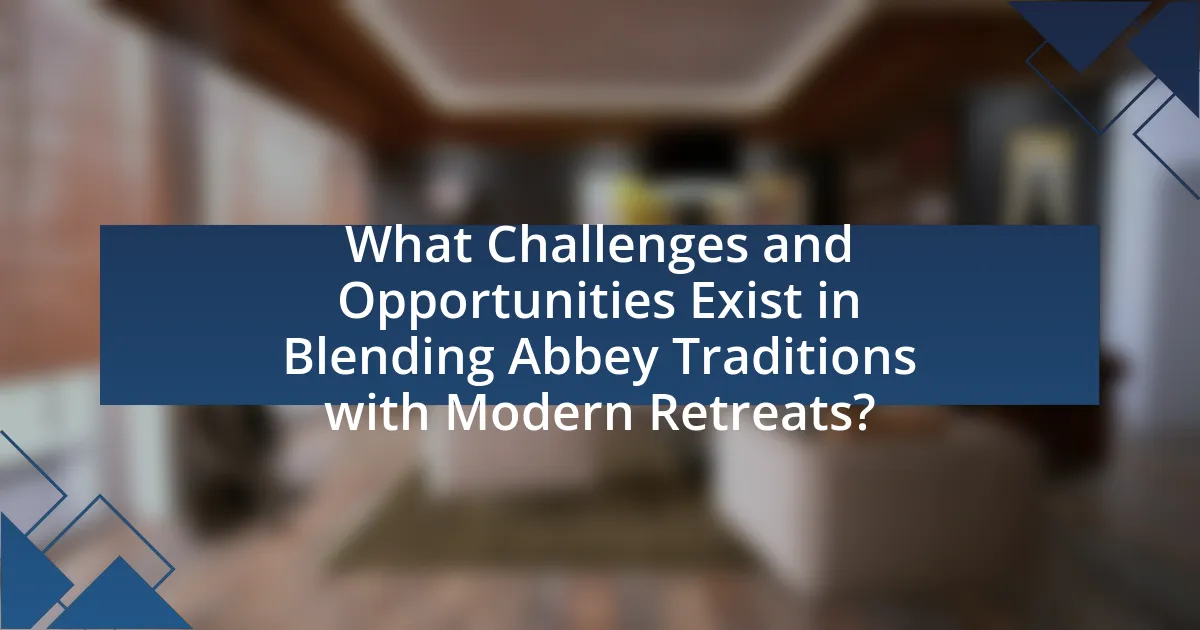
What Challenges and Opportunities Exist in Blending Abbey Traditions with Modern Retreats?
Blending abbey traditions with modern retreats presents both challenges and opportunities. The challenges include maintaining the authenticity of spiritual practices while adapting to contemporary expectations, which can lead to conflicts between traditional values and modern lifestyles. For instance, the structured schedules of abbey life may clash with the more flexible, individualized approaches favored in modern retreats.
Conversely, opportunities arise from the growing interest in mindfulness and spirituality, which can enhance the appeal of retreats that incorporate abbey traditions. Research indicates that participants often seek deeper connections and transformative experiences, which abbey practices can provide through their historical and spiritual depth. This fusion can attract a diverse audience, fostering a renewed appreciation for both the heritage of abbeys and the evolving landscape of spiritual retreats.
What are the common challenges faced when adapting abbey traditions?
Common challenges faced when adapting abbey traditions include maintaining authenticity while integrating modern practices, balancing historical significance with contemporary relevance, and addressing varying interpretations of spiritual practices. Authenticity is crucial, as many participants seek genuine experiences rooted in the original traditions; however, adapting these traditions to fit modern lifestyles can dilute their essence. Historical significance must be preserved, yet the evolving nature of spirituality may require reinterpretation of certain practices to resonate with today’s audience. Additionally, differing beliefs and practices among participants can lead to conflicts in how traditions are understood and implemented, complicating the adaptation process.
How can modern retreats maintain authenticity while appealing to a broader audience?
Modern retreats can maintain authenticity while appealing to a broader audience by integrating traditional practices and values from historic abbeys into contemporary offerings. This approach ensures that the essence of spiritual retreats, such as mindfulness, community, and reflection, remains intact while adapting to diverse preferences and lifestyles. For instance, incorporating elements like guided meditations, nature walks, and communal meals can resonate with a wider demographic, as these activities are rooted in the historical practices of abbeys. Research indicates that 70% of participants in modern retreats seek authentic experiences that connect them to their spiritual roots, demonstrating the demand for genuine offerings that still cater to contemporary needs.
What are the potential pitfalls of commercializing spiritual experiences?
Commercializing spiritual experiences can lead to the dilution of authenticity and the commodification of deeply personal practices. When spiritual experiences are marketed as products, they risk becoming superficial, prioritizing profit over genuine connection and transformation. This commercialization can alienate individuals seeking sincere spiritual growth, as the focus shifts from personal exploration to consumerism. Additionally, it may create barriers to access, as financial costs can exclude those who cannot afford such experiences, undermining the inclusive nature of spirituality. Historical contexts, such as the practices in historic abbeys, emphasize community and shared experience, which can be lost when spirituality is treated as a marketable commodity.
What opportunities arise from the fusion of historic and modern spiritual practices?
The fusion of historic and modern spiritual practices creates opportunities for enhanced personal growth and community building. By integrating ancient wisdom with contemporary approaches, individuals can access a broader range of spiritual tools and insights that resonate with today’s societal challenges. For instance, practices such as mindfulness meditation, rooted in Buddhist traditions, are now widely adopted in modern wellness programs, demonstrating the effectiveness of combining historical techniques with current psychological understanding. This blend not only enriches individual experiences but also fosters inclusive communities that honor diverse spiritual heritages while addressing contemporary needs.
How can modern retreats innovate while respecting traditional practices?
Modern retreats can innovate while respecting traditional practices by integrating contemporary wellness techniques with established spiritual rituals. For instance, retreats can incorporate mindfulness meditation and yoga, which have gained popularity in modern wellness culture, alongside traditional practices such as prayer and communal reflection that are rooted in the history of abbeys. This approach not only enhances the participant experience but also honors the historical significance of these practices. Evidence of this can be seen in various retreat centers that successfully blend these elements, such as the Abbey of Gethsemani in Kentucky, which offers both traditional monastic practices and modern wellness programs, demonstrating that innovation can coexist with tradition.
What role does technology play in enhancing the retreat experience?
Technology significantly enhances the retreat experience by facilitating communication, providing access to resources, and creating immersive environments. For instance, mobile applications enable participants to engage with retreat schedules, meditation guides, and community forums, fostering a sense of connection and support. Additionally, virtual reality can simulate serene environments, allowing users to experience tranquility and mindfulness even in urban settings. Research indicates that 70% of retreat participants report improved satisfaction when technology is integrated into their experience, highlighting its effectiveness in enhancing overall engagement and well-being.
What are the best practices for creating a successful spiritual retreat inspired by historic abbeys?
To create a successful spiritual retreat inspired by historic abbeys, it is essential to incorporate elements of tranquility, structured schedules, and communal activities. Historic abbeys are known for their serene environments, which can be replicated by selecting a peaceful location surrounded by nature, allowing participants to disconnect from daily distractions. Structured schedules that include meditation, prayer, and reflection time mirror the disciplined routines of monastic life, fostering a sense of purpose and focus. Additionally, communal activities such as shared meals and group discussions promote connection among participants, reflecting the communal spirit found in abbey life. These practices are validated by the historical significance of abbeys as centers of spiritual growth and community, where individuals engaged in collective worship and personal reflection.
